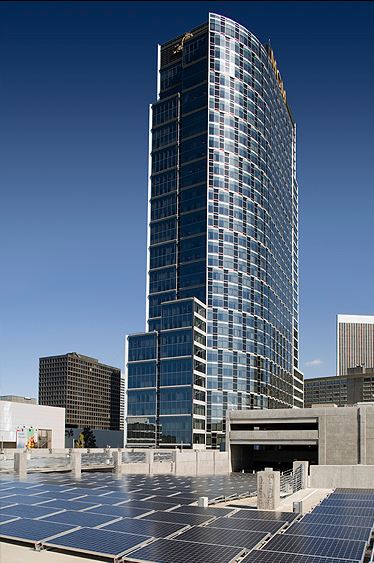For facility managers, seasonal changes are always a challenge. External temperatures fluctuate. Occupant attire straddles the coverage spectrum. You can tell by the flood of emails that you receive (and the dirty looks that you get at lunch) that occupant comfort is not optimal. It doesn’t have to be that way. Occupant comfort is a tricky science. As a facility manager, you balance the temperatures between 72° – 76° F for your office spaces because you know the workers will be sedentary. In more active environments, like retail and schools, you drop the temperatures between 68° – 74° F. You know that these temperature ranges will keep about 90 percent of the occupants happy, which is the industry standard. Yet the ASHRAE recommended temperature ranges are broad enough to cause discomfort amongst the 90 percent, especially during changes in season. Biological differences play a role in comfortable conditions. Yardi LOBOS® (Load Based Optimization System) for commercial properties makes it easier to achieve optimal occupant comfort while saving energy even during seasonal transitions. LOBOS is an intelligent HVAC energy optimization software platform that can help you maximize efficiency, by automating demand management, peak load reduction. and demand response events. It does this by sending temperature, pressure, and speed set point adjustment signals to the existing HVAC components every 60 seconds to produce just enough cooling resources to satisfy the cooling demand in the spaces The LOBOS Cloud automatically stores HVAC trend data that operators find useful in creating a host of ad hoc reports of system operation and performance. The LOBOS software suite gives you a complete understanding of how your building is performing and automatically makes subtle real-time adjustments to maximize occupant comfort and energy savings. Adding LOBOS to an existing HVAC system typically...
Efficiency Reigns
Commercial Survey
If you haven’t prioritized the energy efficiency of your commercial properties, you’ve already fallen behind the curve. Corporate mandates requiring the lease of green buildings have nearly tripled. Prospects are willing—and now able—to pay a premium for energy efficient spaces. The Institute of Building Efficiency issued a survey to 687 VPs, facilities managers, owners and C-level personnel across the nation. Their buildings range from under 50,000 square feet to beyond 500,000 square feet. The results of the report revealed that energy efficiency has become a top priority and growing investment for building owners. When asked about their views on energy efficiency, 46 percent of survey respondents said they paid “a lot more” attention to energy efficiency in the previous 12 months than they had in prior years. Of the executives surveyed, 68 percent plan on increasing their investments in efficiency and renewables. In the past, third-party rebates and incentives furnished the bulk of financing for commercial efficiency upgrades. Yet with such resources dwindling, owners are earmarking monies within their own budgets. Financing called “energy- or climate-specific set-asides within the capital budget” nearly doubled last year to 30 percent from 17 percent in 2012. Meanwhile, energy service agreements increased to 32 percent from 21 percent in 2012/2013. The benefits of energy efficiency have proven their worth. Executives, managers, and tenants choose energy efficient buildings over conventional buildings. This year, 36 percent of respondents expressed that they would be willing to pay top dollar for an efficient space. This is more than double the 15 percent of participants who reported that they would pay a premium in 2013. Many are willing to pay the premium because efficient spaces are a mounting requirement by leadership. 10 percent of respondents reported that corporate policy mandates the lease of...
LOBOS
Providing Utility Solutions
In efforts to reduce energy consumption and CO2 emissions, commercial real estate leaders are turning to sustainable building and management techniques. While there are countless products and services on the market to improve efficiency in these areas, few offer an unobtrusive option that is designed to interface seamlessly with existing HVAC control systems in most modern buildings–LOBOS is different. Whether it is a newly constructed building or a recent renovation, even the greenest buildings can achieve greater energy and cost savings with LOBOS. Yardi subsidiary Enerliance produces the Load Based Optimization System (LOBOS), an advanced software platform that layers on top of existing HVAC control systems to dramatically reduce energy consumption in large buildings and campuses. The system provides automated energy efficiency reset control strategies, real-time automated demand response functionality (“Smart Grid”), system fault detection and diagnostics, and continuous commissioning. By adding LOBOS to the Yardi Energy solutions bundle of offerings, our customers can enjoy the maximum gains in energy efficiency and savings possible today. Scot Duncan, Enerliance founder, commends the relationship between software and utilities, “LOBOS is delivering owner-friendly, tenant-friendly demand reduction which benefits the community, owners and occupants alike. This is a great example of the facilities community working with the utility to prevent brownouts and blackouts, reduce the need to build new power plants, and to manage energy costs for the facility,” says Duncan. LOBOS is a comfort based system. That is, it monitors and controls cooling, heating and air handling systems to improve occupant comfort while simultaneously reducing utility costs for building owners and tenants. To date, LOBOS has been installed in over 400 buildings and has delivered more than $7 million in annual energy savings to clients, or nearly 143 million kWh. The results have garnered an honored position for...



